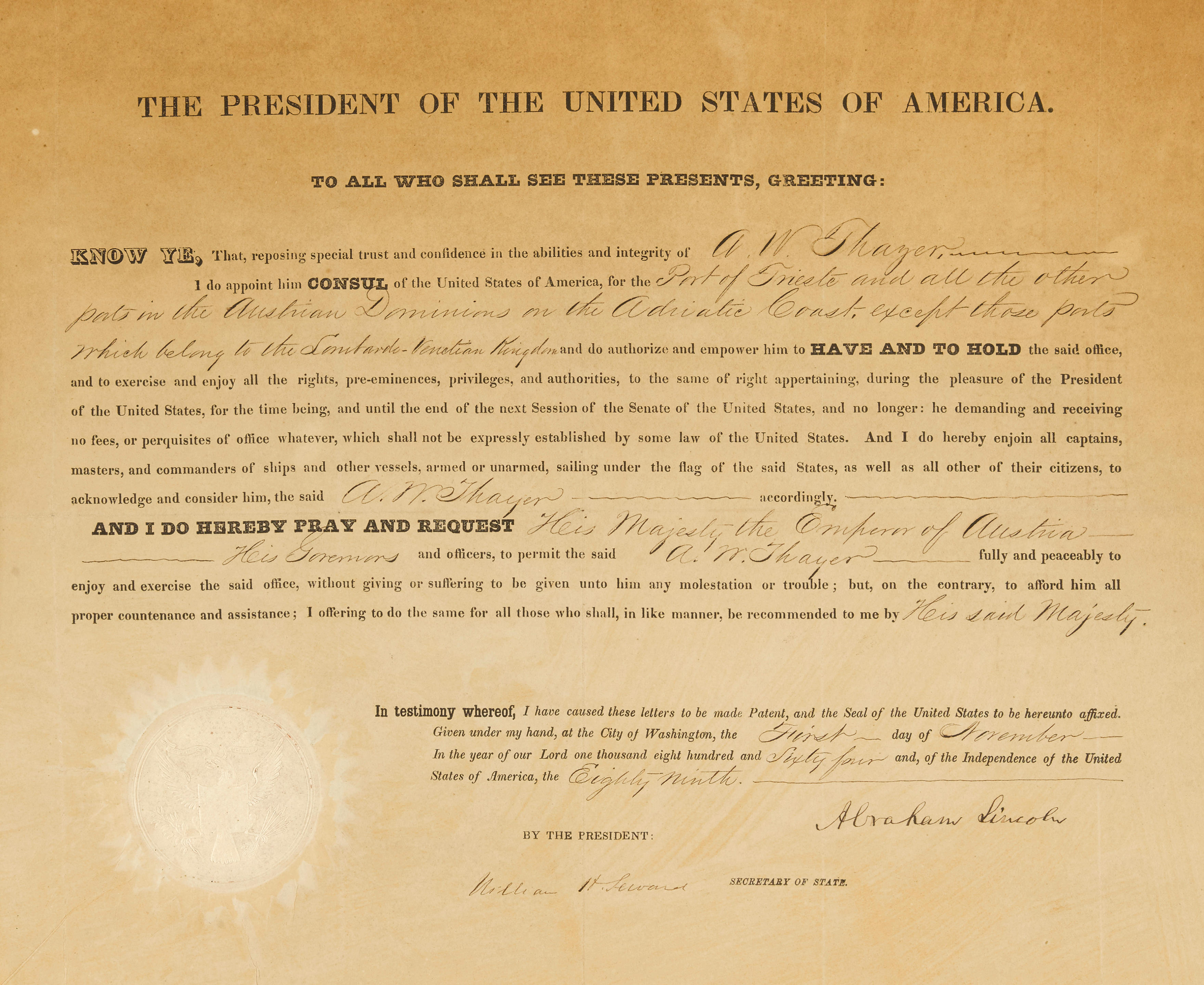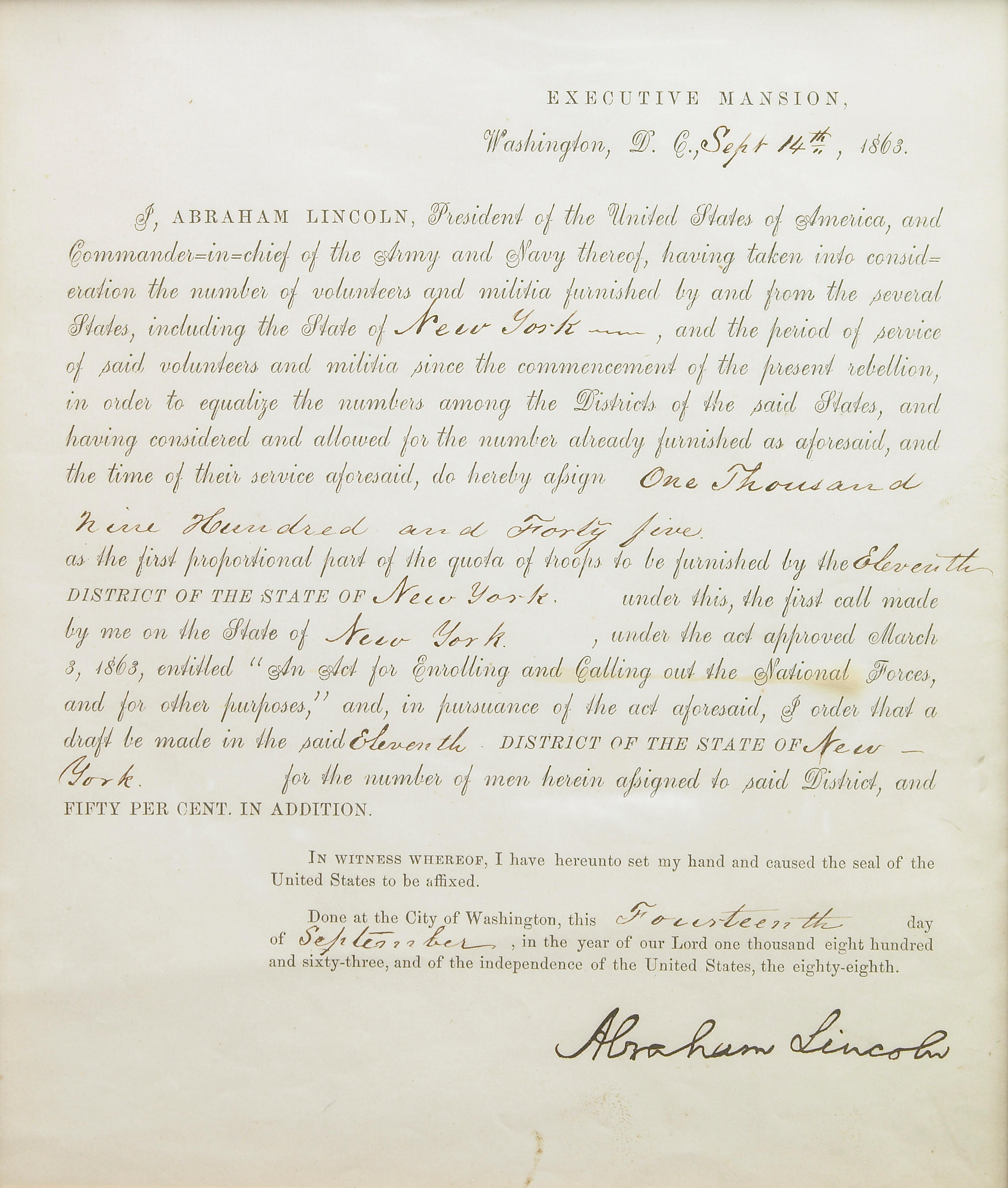LINCOLN, ABRAHAM, President .] GERMAN, Christopher S., daguerreotypist . Quarter-plate daguerreotype portrait of Abraham Lincoln, probably taken in Springfield, Illinois, on or about 23 September 1858. 110 by 82mm. (image), 118 x 92 (case). Minor scratches to lower right portion (Lincoln's coat lapels). Original case: decorative brass mat with retainer (small chip at lower right side), embossed leather covered hinged case (hinge partly loose), embossed red velvet facing compartment. Mellon, Face of Lincoln , p.40; Hamilton & Ostendorf, Lincoln in Photographs , O-9 (from the albumen); Holzer, Boritt and Neely, The Lincoln Image , p.58, Figure 27. THE LINCOLN OF THE LINCOLN-DOUGLAS DEBATES: AN EXCEPTIONAL EARLY DAGUERREOTYPE, ONE OF ONLY TWO KNOWN, GIVEN BY LINCOLN TO HARRIET CHAPMAN, DAUGHTER OF LINCOLN'S COUSIN, DENNIS HANKS. An exceptional image and one of the most important early photographs of Lincoln to be offered in years. The finely detailed portrait shows a three-quarter image of the future President, beardless, seated, posed in front of a hanging curtain, gazing strongly and resolutely at the camera. The tonalities of the image, though dark, are exceptionally good. The image, made after an albumen, is reversed. The only other daguerreotype of this portrait is in the Library of Congress. In the fall of 1858, Lincoln, as a successful lawyer, was well-known in his hometown of Springfield and in the state of Illinois, but largely unknown outside the state. As the acknowledged leader of the Illinois Republicans, he resolved to run against incumbent Democrat Stephen A. Douglas for an Illinois Senate seat. In the course of this key political contest, the opponents faced off in a series of seven public debates in different Illinois towns from June to October 1858. Widely attended and closely reported in the national press, the Lincoln-Douglas Debates cemented Lincoln's reputation in anti-slavery circles, made him a national political figure and, ultimately, made him the successful contender, a year later, for the Republican Presidential nomination. The fourth Lincoln-Douglas debate took place in Charleston, Illinois on 18 September 1858. In Charleston, Lincoln lodged with close relatives: Harriet and A.H. Chapman. Mrs. Chapman was the daughter of Lincoln's cousin, Dennis Friend Hanks (1799-1892), who had lived with the Lincolns when Abraham was young. She was also the granddaughter of Lincoln's stepmother, Sarah Bush Johnston Lincoln (1788-1869). Harriet, perhaps proud of the attention being paid to her Springfield relation, asked Lincoln for a photograph of himself. "Well, Harriet," Lincoln is reported to have answered, "when I get home I will have one taken for you." Back in Springfield, Lincoln sat for a local photographer, probably Christopher Smith German. German produced several albumen prints (Ostendorf, p.20, illustrates an example in the Illinois State Historical Library). But Lincoln apparently wanted something more substantial than a print mounted on paper to give his relations, and German accordingly produced, at his direction, two glass-plate cased daguerreotypes. The extra expense yielded a more elegant and more personal gift, appropriate for a family member, in a decorative case. The other example is presently in the Library of Congress. Lincoln, with characterist modesty, professed not to be pleased with the portrait, and when he forwarded the daguerreotype to Harriet Chapman, his letter of transmittal noted that "this is not a very good-looking picture, but it's the best that could be produced from the poor subject" (that letter is not extant). Harriet's son, R.N. Chapman, communicated the story of the photograph to Lincoln biographer Ida M. Tarbell. She published a retouched version of the image with an account of the Chapman provenance in McClure's Magazine , vol.6, no.2 (January 1896), pp.118-119. Provenance : 1. Harriet Chapman, gift of Abraham Lincoln 2. R.N. Chapman, son of the above 3. Major Wil
LINCOLN, ABRAHAM, President .] GERMAN, Christopher S., daguerreotypist . Quarter-plate daguerreotype portrait of Abraham Lincoln, probably taken in Springfield, Illinois, on or about 23 September 1858. 110 by 82mm. (image), 118 x 92 (case). Minor scratches to lower right portion (Lincoln's coat lapels). Original case: decorative brass mat with retainer (small chip at lower right side), embossed leather covered hinged case (hinge partly loose), embossed red velvet facing compartment. Mellon, Face of Lincoln , p.40; Hamilton & Ostendorf, Lincoln in Photographs , O-9 (from the albumen); Holzer, Boritt and Neely, The Lincoln Image , p.58, Figure 27. THE LINCOLN OF THE LINCOLN-DOUGLAS DEBATES: AN EXCEPTIONAL EARLY DAGUERREOTYPE, ONE OF ONLY TWO KNOWN, GIVEN BY LINCOLN TO HARRIET CHAPMAN, DAUGHTER OF LINCOLN'S COUSIN, DENNIS HANKS. An exceptional image and one of the most important early photographs of Lincoln to be offered in years. The finely detailed portrait shows a three-quarter image of the future President, beardless, seated, posed in front of a hanging curtain, gazing strongly and resolutely at the camera. The tonalities of the image, though dark, are exceptionally good. The image, made after an albumen, is reversed. The only other daguerreotype of this portrait is in the Library of Congress. In the fall of 1858, Lincoln, as a successful lawyer, was well-known in his hometown of Springfield and in the state of Illinois, but largely unknown outside the state. As the acknowledged leader of the Illinois Republicans, he resolved to run against incumbent Democrat Stephen A. Douglas for an Illinois Senate seat. In the course of this key political contest, the opponents faced off in a series of seven public debates in different Illinois towns from June to October 1858. Widely attended and closely reported in the national press, the Lincoln-Douglas Debates cemented Lincoln's reputation in anti-slavery circles, made him a national political figure and, ultimately, made him the successful contender, a year later, for the Republican Presidential nomination. The fourth Lincoln-Douglas debate took place in Charleston, Illinois on 18 September 1858. In Charleston, Lincoln lodged with close relatives: Harriet and A.H. Chapman. Mrs. Chapman was the daughter of Lincoln's cousin, Dennis Friend Hanks (1799-1892), who had lived with the Lincolns when Abraham was young. She was also the granddaughter of Lincoln's stepmother, Sarah Bush Johnston Lincoln (1788-1869). Harriet, perhaps proud of the attention being paid to her Springfield relation, asked Lincoln for a photograph of himself. "Well, Harriet," Lincoln is reported to have answered, "when I get home I will have one taken for you." Back in Springfield, Lincoln sat for a local photographer, probably Christopher Smith German. German produced several albumen prints (Ostendorf, p.20, illustrates an example in the Illinois State Historical Library). But Lincoln apparently wanted something more substantial than a print mounted on paper to give his relations, and German accordingly produced, at his direction, two glass-plate cased daguerreotypes. The extra expense yielded a more elegant and more personal gift, appropriate for a family member, in a decorative case. The other example is presently in the Library of Congress. Lincoln, with characterist modesty, professed not to be pleased with the portrait, and when he forwarded the daguerreotype to Harriet Chapman, his letter of transmittal noted that "this is not a very good-looking picture, but it's the best that could be produced from the poor subject" (that letter is not extant). Harriet's son, R.N. Chapman, communicated the story of the photograph to Lincoln biographer Ida M. Tarbell. She published a retouched version of the image with an account of the Chapman provenance in McClure's Magazine , vol.6, no.2 (January 1896), pp.118-119. Provenance : 1. Harriet Chapman, gift of Abraham Lincoln 2. R.N. Chapman, son of the above 3. Major Wil




.jpg)









Testen Sie LotSearch und seine Premium-Features 7 Tage - ohne Kosten!
Lassen Sie sich automatisch über neue Objekte in kommenden Auktionen benachrichtigen.
Suchauftrag anlegen